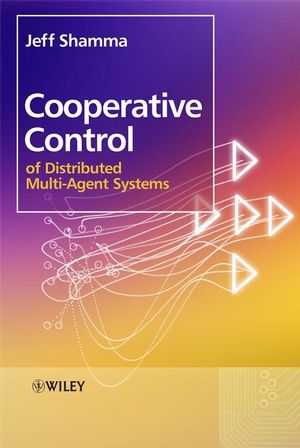Cooperative Control of Distributed Multi-Agent SystemsISBN: 978-0-470-06031-5
Hardcover
452 pages
January 2008
 |
||||||
Preface.
Part I. Introduction.
1. Dimensions of cooperative control (Jeff S. Shamma and Gurdal Arslan).
1.1 Why cooperative control?
1.2 Dimensions of cooperative control.
1.3 Future directions.
Acknowledgements.
References
Part II. Distributed Control and Computation.
2. Design of behavior of swarms: From flocking to data fusion using microfilter networks (Reza Olfati-Saber).
2.1 Introduction.
2.2 Consensus problems.
2.3 Flocking behavior for distributed coverage.
2.4 Microfilter networks for cooperative data fusion.
Acknowledgements.
References.
3. Connectivity and convergence of formations (Sonja Glavaski, Anca Williams and Tariq Samad).
3.1 Introduction.
3.2 Problem formulation.
3.3 Algebraic graph theory.
3.4 Stability of vehicle formations in the case of time-invariant communication.
3.5 Stability of vehicle formations in the case of time-variant communication.
3.6 Stabilizing feedback for the time-variant communication case.
3.7 Graph connectivity and stability of vehicle formations.
3.8 Conclusion.
Acknowledgements.
References.
4. Distributed receding horizon control: stability via move suppression (William B. Dunbar).
4.1 Introduction.
4.2 System description and objective.
4.3 Distributed receding horizon control.
4.4 Feasibility and stability analysis.
4.5 Conclusion.
Acknowledgements.
References.
5. Distributed predictive control: synthesis, stability and feasibility (Tam´as Keviczky, Francesco Borrelli and Gary J. Balas).
5.1 Introduction.
5.2 Problem formulation.
5.3 Distributed MPC scheme.
5.4 DMPC stability analysis.
5.5 Distributed design for identical unconstrained LTI subsystems.
5.6 Ensuring feasibility.
5.7 Conclusion.
References.
6. Task assignment for mobile agents (Brandon J. Moore and Kevin M. Passino).
6.1 Introduction.
6.2 Background.
6.3 Problem statement.
6.4 Assignment algorithm and results.
6.5 Simulations.
6.6 Conclusions.
Acknowledgements.
References.
7. On the value of information in dynamic multiple-vehicle routing problems (Alessandro Arsie, John J. Enright and Emilio Frazzoli ).
7.1 Introduction.
7.2 Problem formulation.
7.3 Control policy description.
7.4 Performance analysis in light load.
7.5 A performance analysis for sTP, mTP/FG and mTP policies.
7.6 Some numerical results.
7.7 Conclusions.
References.
8. Optimal agent cooperation with local information (Eric Feron and Jan DeMot).
8.1 Introduction.
8.2 Notation and problem formulation.
8.3 Mathematical problem formulation.
8.4 Algorithm overview and LP decomposition.
8.5 Fixed point computation.
8.6 Discussion and examples.
8.7 Conclusion.
Acknowledgements.
References.
9. Multiagent cooperation through egocentric modeling (Vincent Pei-wen Seah and Jeff S. Shamma).
9.1 Introduction.
9.2 Centralized and decentralized optimization.
9.3 Evolutionary cooperation.
9.4 Analysis of convergence.
9.5 Conclusion.
Acknowledgements.
References.
Part III. Adversarial Interactions.
10. Multi-vehicle cooperative control using mixed integer linear programming (Matthew G. Earl and Raffaello D’Andrea).
10.1 Introduction.
10.2 Vehicle dynamics.
10.3 Obstacle avoidance.
10.4 RoboFlag problems.
10.5 Average case complexity.
10.6 Discussion.
10.7 Appendix: Converting logic into inequalities.
Acknowledgements.
References.
11. LP-based multi-vehicle path planning with adversaries (Georgios C. Chasparis and Jeff S. Shamma).
11.1 Introduction.
11.2 Problem formulation.
11.3 Optimization set-up.
11.4 LP-based path planning.
11.5 Implementation.
11.6 Conclusion.
Acknowledgements.
References.
12. Characterization of LQG differential games with different information patterns (Ashitosh Swarup and Jason L. Speyer).
12.1 Introduction.
12.2 Formulation of the discrete-time LQG game.
12.3 Solution of the LQG game as the limit to the LEG Game.
12.4 LQG game as the limit of the LEG Game.
12.5 Correlation properties of the LQG game filter in the limit.
12.6 Cost function properties—effect of a perturbation in up.
12.7 Performance of the Kalman filtering algorithm.
12.8 Comparison with the Willman algorithm.
12.9 Equilibrium properties of the cost function: the saddle interval.
12.10 Conclusion.
Acknowledgements.
References.
Part IV. Uncertain Evolution.
13 Modal estimation of jump linear systems: an information theoretic viewpoint (Nuno C. Martins and Munther A. Dahleh).
13.1 Estimation of a class of hidden markov models.
13.2 Problem statement.
13.3 Encoding and decoding.
13.4 Performance analysis.
13.5 Auxiliary results leading to the proof of theorem.
Acknowledgements.
References.
14. Conditionally-linear filtering for mode estimation in jump-linear systems (Daniel Choukroun and Jason L. Speyer).
14.1 Introduction.
14.2 Conditionally-Linear Filtering.
14.3 Mode-estimation for jump-linear systems.
14.4 Numerical Example.
14.5 Conclusion.
14.6 Appendix A: Inner product of equation (14.14).
14.7 Appendix B: Development of the filter equations (14.36) to (14.37).
Acknowledgements.
References.
15. Cohesion of languages in grammar networks (Y. Lee, T.C. Collier, C.E. Taylor and E.P. Stabler).
15.1 Introduction.
15.2 Evolutionary dynamics of languages.
15.3 Topologies of language populations.
15.4 Language structure.
15.5 Networks induced by structural similarity.
15.6 Conclusion.
Acknowledgements.
References.
Part V. Complexity Management.
16. Complexity management in the state estimation of multi-agent systems (Domitilla Del Vecchio and Richard M. Murray).
16.1 Introduction.
16.2 Motivating example.
16.3 Basic concepts.
16.4 Problem formulation.
16.5 Problem solution.
16.6 Example: the RoboFlag Drill.
16.7 Existence of discrete state estimators on a lattice.
16.8 Extensions to the estimation of discrete and continuous variables.
16.9 Conclusion.
Acknowledgements.
References.
17. Abstraction-based command and control with patch models (V. G. Rao, S. Goldfarb and R. D’Andrea).
17.1 Introduction.
17.2 Overview of patch models.
17.3 Realization and verification.
17.4 Human and artificial decision-making.
17.5 Hierarchical control.
17.6 Conclusion.
References.
Index.



